“The illiterate of the 21st century will not be those who cannot read and write, but those who cannot learn, unlearn, and relearn.” – Alvin Toffler
At various stages in your life, you’ll find yourself confronted with the reality that you don’t know everything.
Maybe you’ve just graduated from high school and you’re not convinced you need college to prepare for your career of choice. Or maybe you’re not even sure what you want to do with your life.
Maybe you’ve just started a new job or changed roles and you need to learn some new skills or update your knowledge.
Maybe you’ve picked up a new hobby like photography or coding and you want to learn as much as you can, as quickly and cheaply as possible.
Maybe you’re halfway through a college degree but the pandemic has made you realize you can learn on your own very effectively.
Maybe you’ve just graduated from college and entered the workplace and you’re realizing you still have a lot to learn, but there are no teachers or professors to teach you and measure your knowledge.
Maybe you want to make a career change into a whole new field and you want to get the lay of the land before you make the leap.
No matter what your circumstances or level of education or stage of your career, you’re never going to stop learning.
At the rate at which information is disseminated today – not to mention the rate at which technology is evolving – existing in the modern workplace will demand constant learning. Whether it’s how to use new software or how to perform in a role that didn’t exist before, the ability to learn – and to direct your own learning – is one of the most important skills you can have.
The problem is that the formal education experience (school, college) doesn’t really prepare us to go it alone. K-12 schooling and tertiary education teaches us to memorize knowledge and take tests, but not how to learn.
That’s why this post is dedicated to unpacking the concept of self-directed learning and sharing strategies to help you take charge of your career and education.
What Is Self-Directed Learning?
In a nutshell, self-directed learning is the practice of taking charge of your own education by discovering what you need to learn, setting learning goals, choosing the learning strategies best suited to you, and evaluating your learning outcomes.
Gone are the days when the concept of education was predominantly associated with the hallowed halls of universities and colleges.
Today, there are millions of resources available to help us learn about just about anything under the sun. From blogs to podcasts, to YouTube videos, to online courses, to webinars, to a world of offline learning opportunities like job shadowing, interning, mentorship, etc. – there is so much educational material available that it can seem a little overwhelming at first to decide where to even begin.
This is why self-directed learning is a skill in itself. With so much content available, it’s easy to get distracted if you don’t have a plan, discipline, and commitment.
READ MORE: Check out our Beginner’s Guide to Online Learning.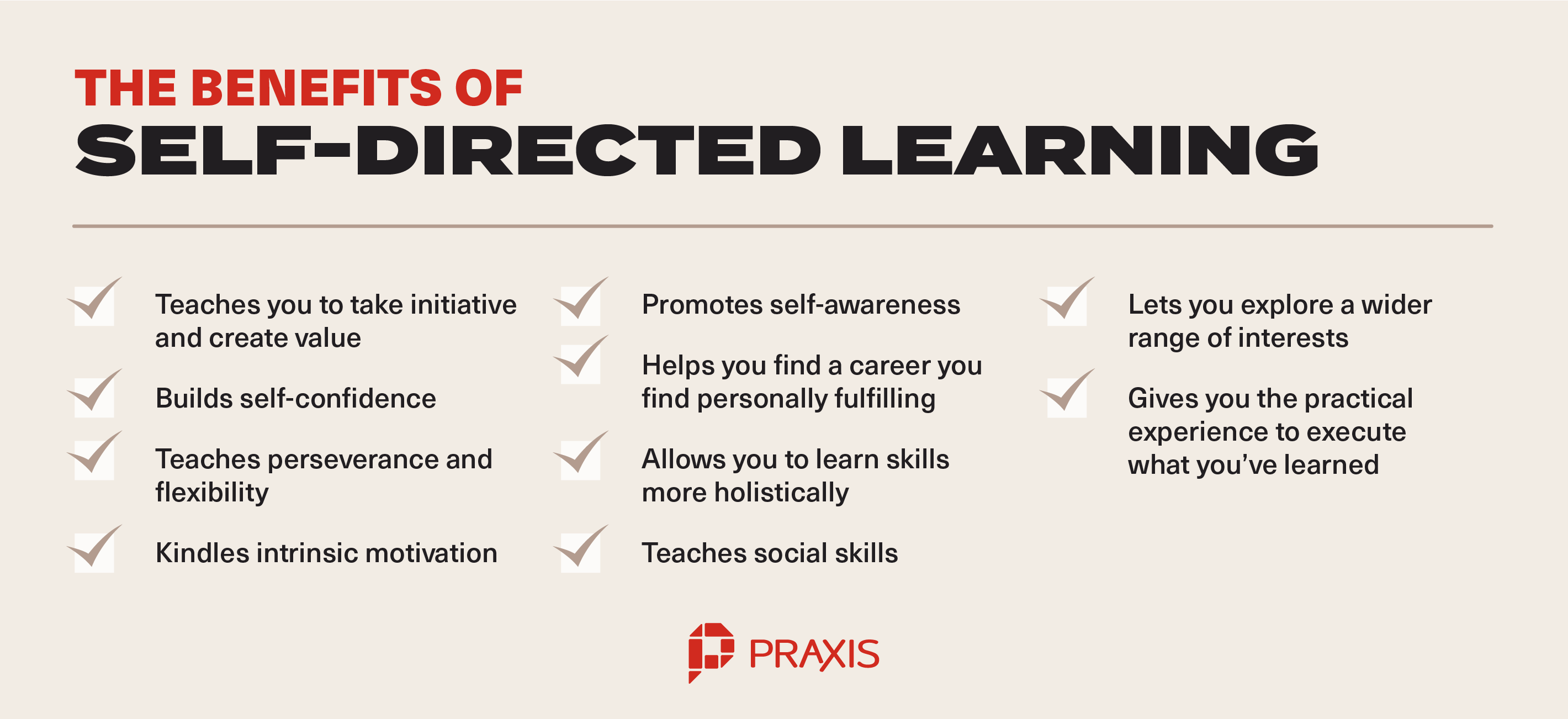
What Makes Self-Directed Learning Effective?
Aside from the fact that you can do it on your own time and save large sums of money by opting for a self-directed education instead of formal education like college, self-directed learning offers a mass of benefits.
One of the most important benefits of self-directed learning is that over time, it cultivates a stronger capability in learners for “how to learn” according to their own learning styles, whereas traditional education often fosters too strong a focus on “what to learn.”
While the traditional student is reliant on someone else directing the learning subject matter and process, the self-directed learner becomes a master of independent learning, regardless of the subject matter.
When intelligence and capability are judged by arbitrary metrics like standardized tests, it’s unsurprising that many (successful!) adults still walk around with a secret fear that they may be exposed as a “failure” or “imposter” at any moment.
Individuals who performed well in school (by the same arbitrary metrics) and received constant praise experience the other side of the same coin. Feeling that they must constantly live up to the “exceptional” person they’ve been told they are, they’re often driven to seek external validation and feel like frauds and failures when they don’t get it, or when their anxiety gets in the way of their performance.
This type of education teaches us to always measure ourselves against others and doesn’t foster intrinsic motivation, initiative-taking, or collaboration. Instead, it makes us risk-averse, lazy, competitive, and externally-motivated.
Self-directed learning, on the other hand:
- Allows you to set the pace of your learning,
- Allows you to choose educational materials that complement your learning style,
- Instils self-confidence,
- Promotes reflection and self-awareness,
- Facilitates decision-making skills and self-trust,
- Teaches you to take initiative,
- Promotes learning through practice and experience,
- Allows you to learn more holistically and incorporate a wider variety of subjects,
- Kindles intrinsic motivation,
- Encourages social learning and collaboration, fostering community and connection,
- Helps you to pursue what truly interests you,
- Increases the likelihood of finding/building a personally fulfilling career,
- Teaches perseverance, integrity, time management, and adaptability,
- Puts you in control and teaches you agency and decision-making skills.
In addition to simply being a more productive and self-fulfilling way of learning, the practice of self-directed learning teaches you the soft skills you need to succeed in the workplace.
A 4-Step Self-Directed Learning Process
Even for the most motivated individual, learning independently can be a challenge – especially at first. Following this four-step process will help you build your “learning muscles” and give your learning some structure, which will make it easier to maintain.
Step 1: Assess Your Learning Style/Preferences
Understanding how you learn best will help you to plan your learning to be as productive and effective as possible. Take some time to evaluate your past study habits and consider what has worked for you in the past.
- How do you prefer to consume information? By listening? Reading? Do you need visuals to learn effectively?
- How do you process information best? By writing? Repeating? Asking questions? Putting what you’ve learned into practice?
- How do you prefer to organize information?
The VARK model, developed by Neil Fleming and David Baume maps out four categories of learning styles: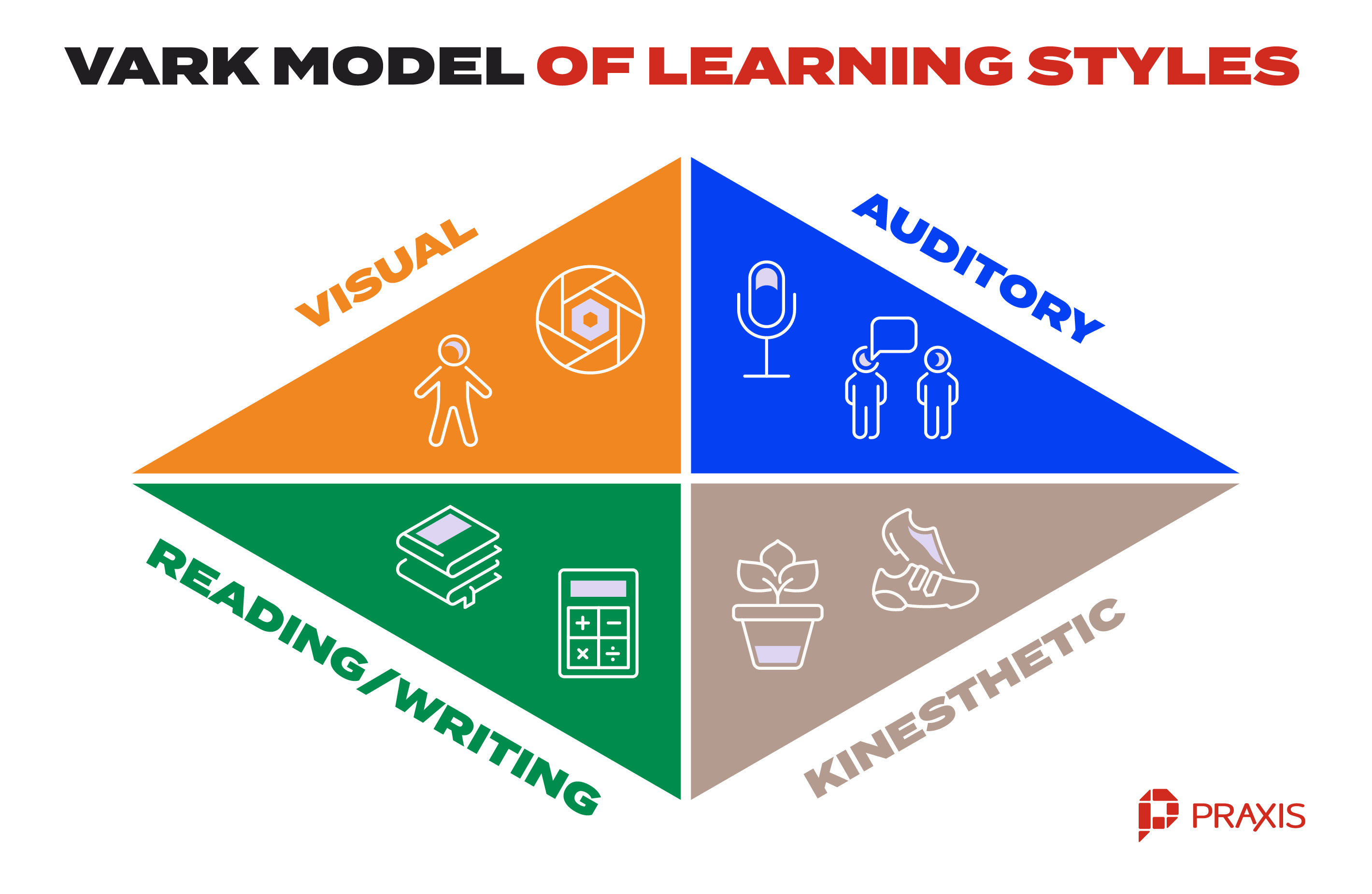
- Visual– Learners who learn best through visual stimulation.
- Auditory– Learners who learn best by listening.
- Reading/writing– Learners who learn best through reading and writing.
- Kinesthetic– Learners who learn best by doing and moving.
Most people combine all of these learning styles in varying ratios but knowing which style is the most efficient way of learning for you can help you to get the most out of your studies.
Assessing factors like your home life situation, how much free time you have available, and what other resources you have or may need access to (like high-speed internet, a library, a mentor, professional networking opportunities, etc.) will also help you to identify potential learning opportunities and limitations and allow you to plan accordingly.
Step 2: Decide What You Want to Learn
Choosing what to learn can be either the easy part or the hard part. If you don’t already have a specific subject of study in mind, such as “how to use Photoshop” or “how to get started in digital marketing,” it’s time to start sampling topics until you find something interesting that you want to invest your time in.
The more you experiment and experience, the sooner you’ll figure out what really excites and interests you. Read more in the “Strategies” section below for tips on how to do this.
Step 3: Set Learning Goals
Setting learning goals is crucial to successful self-directed learning as they provide structure and a timeframe that helps you to hold yourself accountable and allows you to measure your learning. When you have learning goals and know what you want to learn, by when, you can create your own curriculum and steadily work towards that goal.
Here are some of the goals you could outline:
- Goals for the skills or knowledge you want to develop
- Goals for the structure/format of your learning activities
- Goals detailing the educational resources you’ll use
- Goals defining the timeline and sequence of learning activities you’ll complete
- Goals outlining how you’ll evaluate your learning and measure success
It’s also worth deciding how long you’ll keep at a topic if you don’t initially find it as interesting as you expected, and what your criteria for “giving up and moving on” are. How will you weigh whether it’s the subject matter or the learning material that’s not interesting or useful?
On that note, reading reviews and discussions about learning materials when you’re designing your personal curriculum can save you a lot of time filtering out bad content and making sure you learn from the best.
Step 4: Evaluate Learning and Get Feedback
As you engage in the learning process, it’s important that frequently you sit back and reflect on what you’ve learned. This will help you to see how far you’ve come and how far you still have to go.
An excellent way to do this is by blogging. Whether it’s a written blog published on your website or a site like Medium or LinkedIn, or a video blog on YouTube, blogging is a great way to self reflect and really dig into what you know and how you think and feel about it. It also helps to put your new knowledge and skills into context within your greater understanding of the world.
Another benefit is that it puts your learning out into the world and creates an opportunity for feedback, and starting a conversation with experts and others on the same learning journey as yourself will accelerate your learning.
If you’re learning a practical, demonstrable skill like web design or writing or animation or coding (or whatever), you could share your practice projects with communities dedicated to these skills and ask people for feedback and tips. We know, putting yourself out there like that is scary as hell. But it’s one of the fastest ways to improve and stress-test your new skills and knowledge – and to discover what else you need to learn. Learning in a vacuum won’t prepare you for the inevitable real-world tests your knowledge and skills will be put to.
Tips: How to Get the Most Out of Self-Directed Learning
Below, we’ve outlined a few tips to help you optimize your self-directed education experience.
Set SMART Goals
As we’ve mentioned, goal-setting is crucial to productive self-directed learning. For best results, make sure they’re SMART goals:
- Specific: Be precise about what you hope to gain.
- Measurable: Decide how you will track your progress.
- Attainable: Challenge yourself but make sure your goals are realistic and achievable.
- Relevant: Ensure that your goals make sense given your circumstances and what you hope to achieve.
- Time-bound: Create milestones and deadlines to keep you focused and motivated.

Create a Learning Bank
A learning bank is a repository for all the cool and interesting content and learning resources you come across. Whether it’s websites, courses, videos, blog posts, podcasts, news articles – you name it, it can be easy to lose track of all the materials you want to get back to.
Creating a learning bank allows you to stash all this content in a central location. You can then go back and use this repository to construct your curriculum and map specific content pieces to specific days on your calendar to make sure it doesn’t just sit there gathering virtual dust.
Build a Learning Network
Connecting with others who are learning about the same subject as you can be an invaluable boost to your learning, giving you a platform to discuss what you’ve learned, ask questions, and help others to learn from you. Whether your learning network is online or offline, it’s an excellent way to network while building your skills.
Model Successful Self-Learners
Having heroes isn’t just for children. Finding self-driven individuals who are passionate about self-directed learning can be incredibly motivating and inspiring. Not only that, but following successful self-learners in your field of interest can lead you to discover great content recommendations and tips and insights.
Start Small
Don’t wait until you feel like you’re an expert before you put your new skills and knowledge to the test. Test your skills and knowledge incrementally by creating small projects as you learn.
These projects not only give you hands-on practice and experience that facilitate learning and memory, but they also serve as proof of your abilities, which can give your ego a healthy boost and keep you motivated even as you discover areas where your knowledge and skills still need developing. These small projects also reduce the risk of suffering an ego-crushing blow by going all-in on a big project and failing, which could lead you to second-guess your ability to learn and grow.
Make Learning a Priority
To succeed as a self-learner, you need to make learning a priority and manage your time in a way that reflects this. We’re all just the sum of our habits, and if learning is not a regular feature in your calendar, you’ll never reach your learning goals and you’ll start to feel frustrated and harbor guilt about how you spend your time. Don’t let this happen to you. If self-development and professional and personal growth are important to you, make your daily habits reflect this.
Pro tip: Instead of saying “I don’t have time for XYZ,” say “XYZ is not a priority.” See how that feels. If it’s uncomfortable saying that out loud, you know you need to adjust your priorities.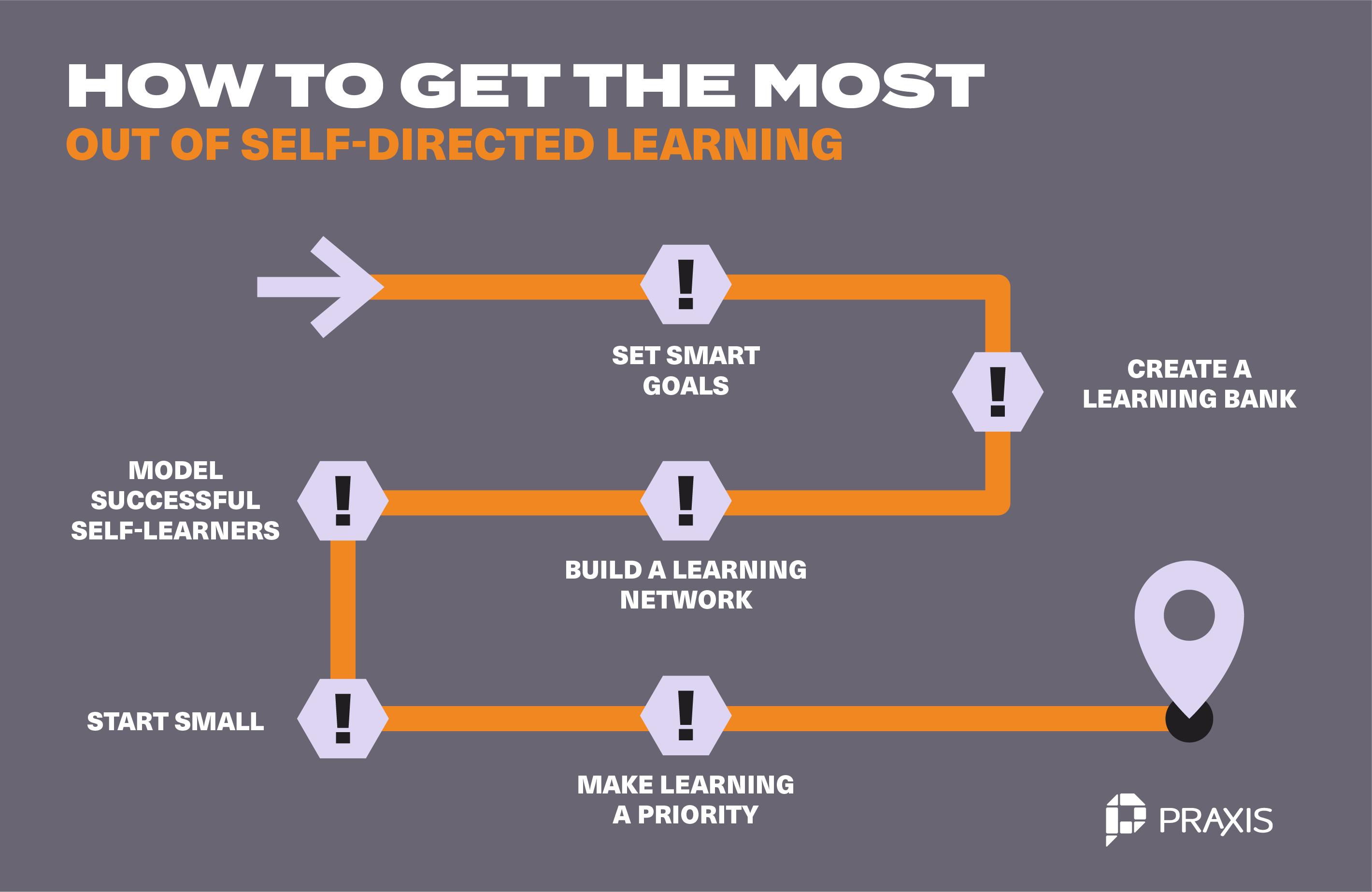
Self-Directed Learning Strategies for Learners
Below, we’ve outlined a variety of different strategies you could apply to your self-directed learning experience. Of course, none of these are “the right way” – everyone’s “right way” is different, so feel free to take what you find useful and discard the rest.
1. Learning Out Loud
Learning out loud means sharing your learning experience with the world as you gain new knowledge and perspectives. Learning out loud exposes you to additional learning opportunities through conversations with fellow learners and experts alike and helps others to learn along with you.
As a bonus, it’s a great way to help build your brand and create a digital footprint that gives prospective employers and customers a sense of who you are and what excites and interests you.
2. The 70:20:10 Model
The 70:20:10 learning model is based on research that found that 70 percent of learners gain most of their knowledge through experience (e.g. practice, on-the-job learning), 20 percent learn through interactions with other people (social, networking, talking to experts, collaborating online, learning from mentors, social media) and only 10 percent learn from formal education events (scheduled training, lectures, seminars, conferences).
Applying this model to your own self-education can accelerate your learning. Think about it – whether you’re learning how to build a website or build code or become a better photographer, you’re going to learn much faster by practicing what you’ve learned than by simply watching hours of tutorials. The key is to find a balance that works for you.
3. The Sandbox Method
The sandbox method is an agile approach to self-directed learning that maximizes the way we learn and process information. Instead of focusing on memorizing facts and details, the sandbox method prioritizes experimentation, action, evaluation, and constant iterative improvement.
The sandbox method is a cyclical process here broken into 5 steps:
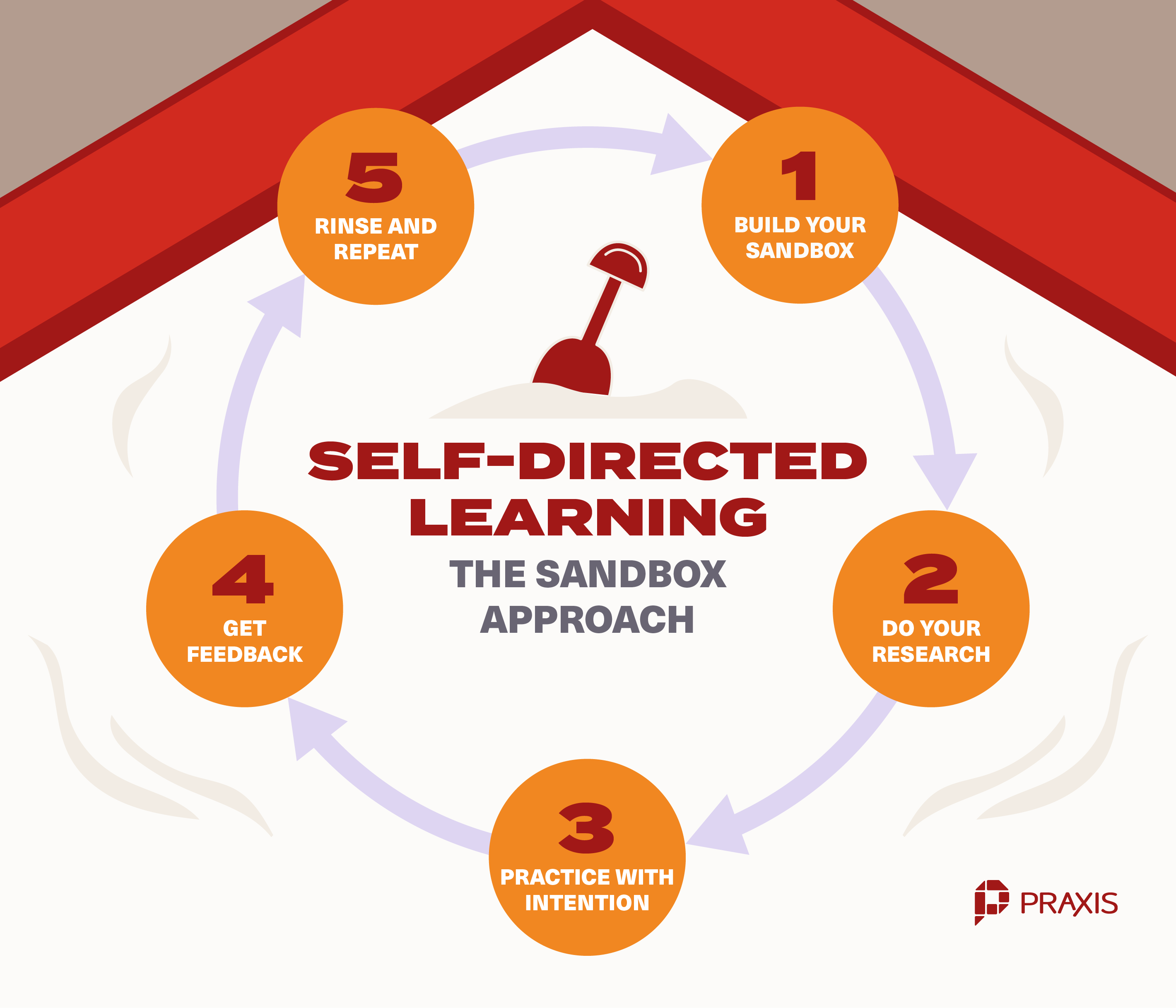
Step 1| Build Your Sandbox
The first step is to create an environment in which you can practice what you learn. Like a sandbox in a children’s playground, this is a space where you can freely play and experiment with the skill you’re learning – without taking it too seriously or placing undue pressure on yourself. The idea is that it’s okay to fail because failing is a way to learn too.
To create the ideal environment for rapid learning, your sandbox should allow you to take risks and explore without financial or reputational risk.
Your sandbox should be:
- Low-cost or free, so you face minimal risk and don’t postpone starting
- Low-stakes, so you don’t hesitate to show your work or fear failure
- Public, so that you have to put your work out into the world
Here are a few examples of sandboxes:
- Writing: A blog on WordPress, Medium, or SquareSpace.
- Photography: An Instagram account.
- Marketing: A website you can try to grow by practicing your marketing skills.
- Programming: A Github or StackExchange account for sharing projects and asking for input.
- Public speaking: Toastmasters, a podcast, or YouTube channel.
- Just about anything else: A YouTube or TikTok channel.
Your sandbox should be in place before you start learning because if you don’t have a place to practice and put your work on display, you’ll postpone it and learn far more slowly. While scary at first, shipping your work regularly will teach you to become comfortable with sharing your projects before they’re perfect (spoiler: they’ll never be perfect).
This is important for two reasons. Firstly, it allows you to get input that can make your work even better, and secondly, it teaches you not to base your self-esteem on how others judge your work so much, which means you’ll be more confident and you’ll grow much faster – and build more authentic and meaningful relationships with the people around you.
Step 2| Do Your Research
Once you have your sandbox in place, it’s time to start researching and finding out more about your target skill.
Invest time in researching which resources are worth reading, listening to, or watching, and prioritize recipe-type content like how-to guides that clearly demonstrate how to apply the skill you’re learning so you can test it out in your sandbox. Theoretical content is helpful too, as it will help you understand the value and applications of the skill you’re learning, but your main focus should be testing and experimenting with your skill in various use cases.
Step 3| Practice with Intention
Now, armed with helpful resources and a sandbox to play in, start practicing with intention. Beware of falling into the “naive practice” trap, in which you trick yourself into thinking that you’re practicing when you’re actually just repeating things you already know. Be sure to challenge yourself continuously if you want to really get the most out of your learning.
Naïve practice examples include:
- Building new websites using exactly the same steps or templates you used before
- Applying the same filters and editing to all your photos.
- Using the same recipes every time because they worked in the past.
- Practicing songs you can already play.
Practicing with intention means that you:
- Honestly evaluate your capabilities and limitations to identify areas for improvement.
- Set goals that are slightly beyond your current capabilities to force yourself to stretch and exit your comfort zone.
- Practice with your full attention.
- Ask for feedback, in any way available to you, and integrate this feedback into future practice.
Step 4| Get Feedback
Getting feedback is the final stage in the cycle. As we’ve mentioned above, learning in a vacuum won’t give you a very good idea of your actual level of proficiency. More importantly, doing so robs you of valuable opportunities for learning from others and discovering mistakes that you weren’t even aware you were making.
You can learn a lot on your own, but without feedback, you’ll eventually reach a learning plateau. Finding a coach or mentor can be invaluable, as are community platforms like Reddit, Quora, StackExchange, Lang-8, and many others. You could even get creative and hire a freelancer or consultant to critique your work, or reach out to someone in your network and pick their brain over coffee.
The bottom line is, you need targeted, specific feedback if you want to keep improving, so don’t neglect this part of the process.
Step 5| Rinse and Repeat
That’s it. When you’ve followed the four steps outlined above, you simply repeat the process and keep improving. Once you feel like you’ve achieved your learning goal, return to your research phase to identify which areas you could still improve and assess which resources will help you learn those aspects of your skill. Continue practicing and sharing your work and asking for feedback and keep growing your skill and pushing your limits.
Enjoy Your Self-Directed Learning Experience!
Once you discover your tried and true method for approaching any self-directed learning subject, that skill in itself will prove useful in work, classrooms, and your everyday life. Any leader of their field has had to teach themselves to take their learning outside of traditional methods and find new avenues for gathering and practicing knowledge. Whatever skillset or knowledge you may be trying to develop for yourself, don’t be afraid to experiment, discover new sources for yourself, and above all, enjoy the process!
If you want to accelerate your self-directed learning using the sandbox method, apply for Praxis, the college alternative that puts you in control of your education and career.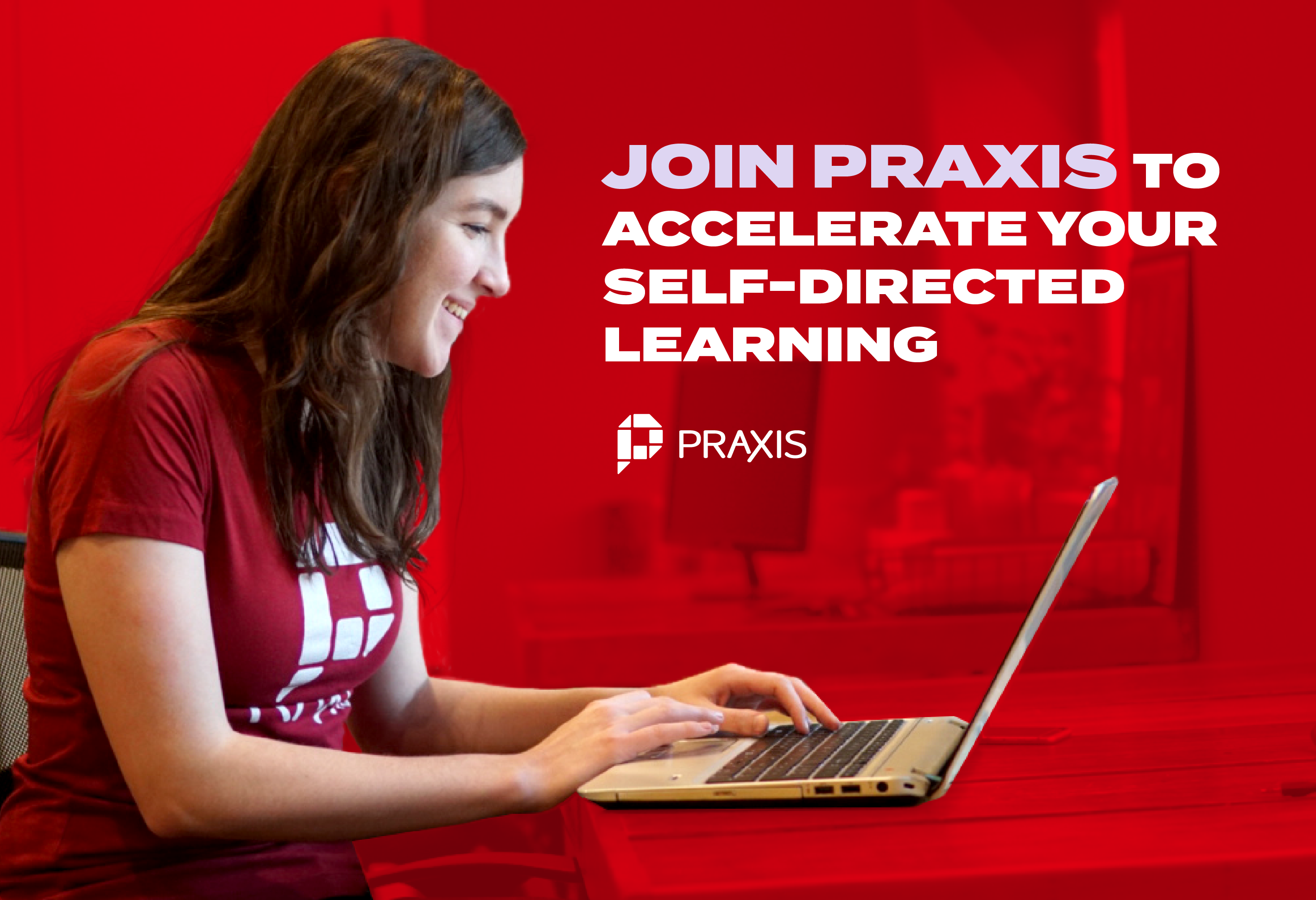
Tags:
Career DevelopmentNovember 9, 2020
